How did BitMine, a Bitcoin mining company, rise to become the world's largest ETH corporate holder in just two months?
Article Author: Lesley
Source: MetaEra
On June 30, 2025, BitMine Immersion Technologies (NYSE: BMNR) announced the launch of a $250 million private placement, officially shifting to an Ethereum ($ETH) treasury strategy. At the same time, Thomas Lee, founder and chief investment officer of the renowned investment firm Fundstrat, was appointed as the chairman of the company's board and personally participated in the investment. Soon after, heavyweight Wall Street figures, including former PayPal CEO Peter Thiel and ARK Investment Management CEO Cathie Wood, followed suit, providing strong capital endorsement for this strategic transformation.
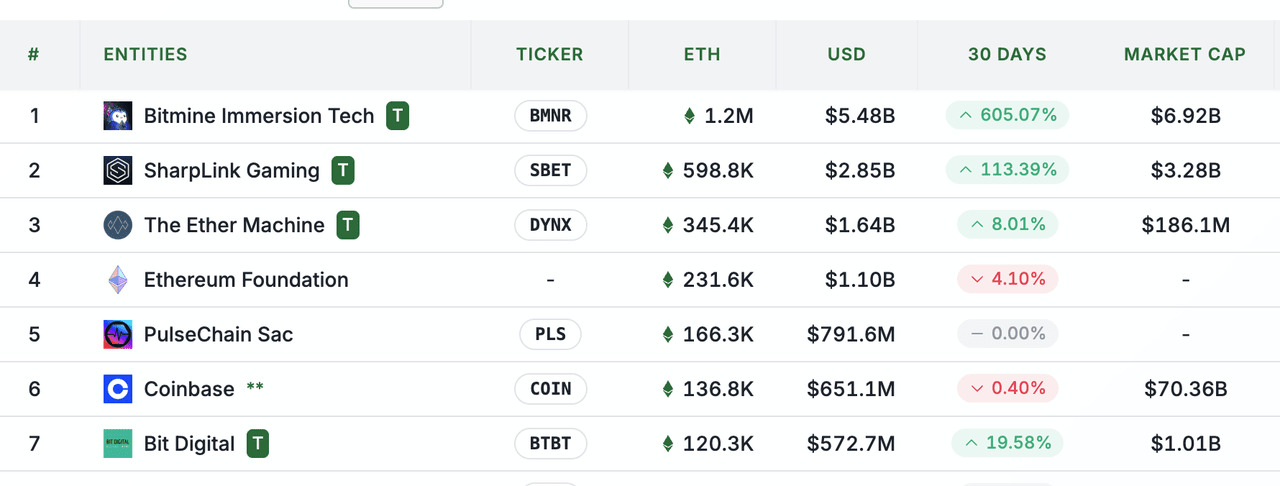
Forty days later, the market provided a clear response. This Bitcoin mining company has become the focal point of the capital market. As of August 14, BitMine, with approximately 1.2 million ETH held cumulatively, valued at about $5.48 billion, has become the world's largest Ethereum corporate holder.
Stock price trends more intuitively reflect market sentiment: up 605.07% in 30 days, with a three-month increase of 1214.38%. From any perspective, this is a textbook-level operation in the capital market.
Behind the numbers lies a reallocation of capital. BitMine's shift from the traditional 'Bitcoin mining monetization' model to a 'long-term holding of Ethereum' treasury strategy essentially represents a transition from industrial capital to financial capital. The success of this model not only proves the feasibility of digital assets as corporate reserve assets but, more importantly, it may be opening up a new pathway for traditional financial institutions to participate in the crypto economy.
How did BitMine, a Bitcoin mining company, rise to become the world's largest ETH corporate holder in just two months? This article will provide an in-depth analysis.
Execution Status and In-depth Analysis of BitMine's Treasury Strategy
From the launch of the $250 million private placement on June 30 to becoming the world's largest ETH corporate holder, BitMine demonstrated the power of the Digital Asset Treasury (DAT) model with a textbook-level capital operation.
Timeline of BitMine's Ethereum Treasury Strategy
BitMine's ETH accumulation trajectory presents a textbook-level rhythm of capital allocation, with each step meticulously designed:
On June 30, 2025: BitMine announced the launch of a $250 million private placement plan to implement its Ethereum treasury strategy. Thomas Lee officially became the chairman of the company’s board and led the company in advancing this new strategy.
On July 9, 2025, BitMine announced the completion of its $250 million private placement plan, further advancing its asset-light treasury strategy.
On July 14, 2025: The company announced that it holds over $500 million worth of ETH.
On July 17, 2025: The company announced that it holds over $1 billion worth of ETH.
On July 24, 2025: Holding over $2 billion worth of ETH, establishing a leadership position in the Ethereum treasury space.
On August 4, 2025: Holding over 833,000 ETH tokens, valued at over $2.9 billion, becoming the world's largest ETH treasury.
On August 11, 2025: Holding over 1.15 million ETH tokens, valued at over $4.96 billion, with an increase of $2 billion again within a week.
On August 12, 2025: Bitmine Immersion submitted documents to U.S. federal regulators to increase its fundraising target for purchasing ETH by an additional $20 billion, raising it to $24.5 billion, to solidify its position as the world's largest ETH treasury.
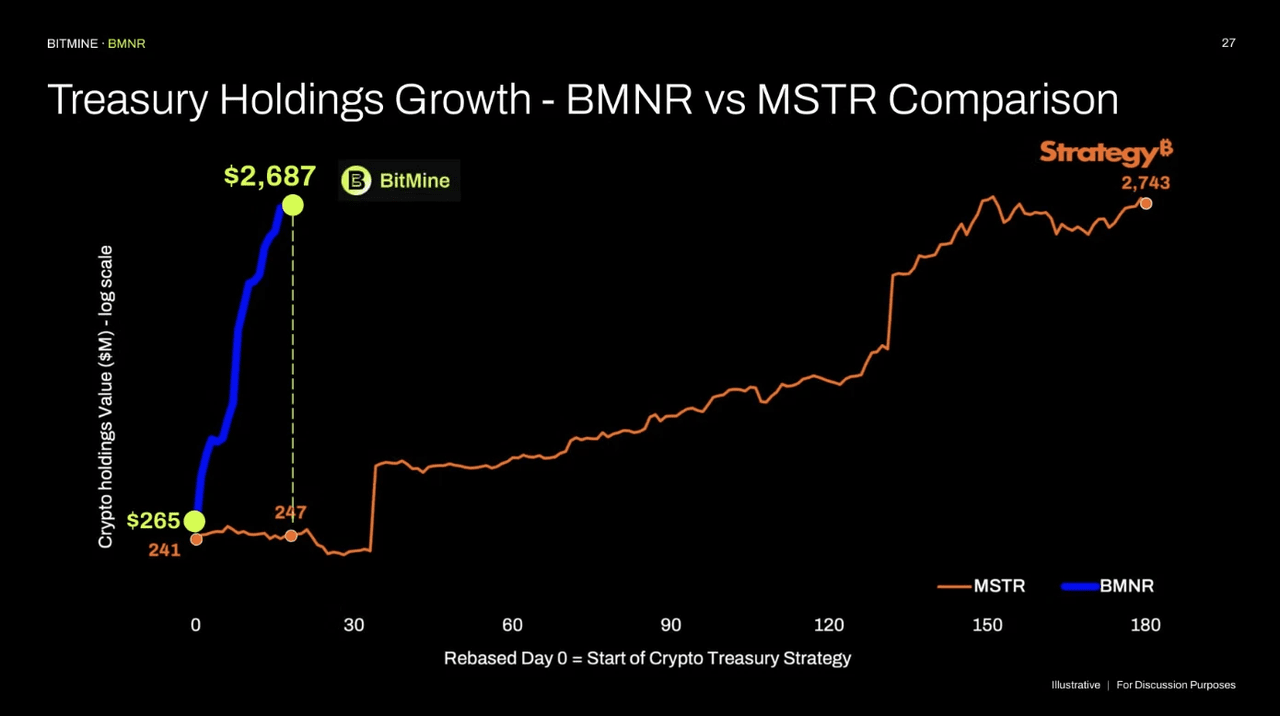
This accumulation speed is rare in capital markets—during the first month of launching the Ethereum treasury strategy, BitMine's per-share ETH growth rate has already surpassed the cumulative growth of Strategy (formerly MicroStrategy) in the first six months.
In-depth Analysis of BitMine's Ethereum Treasury Strategy
Why choose the digital asset treasury strategy?
DAT (Digital Asset Treasury) refers to an emerging model where enterprises incorporate cryptocurrencies like Bitcoin and Ethereum as strategic reserve assets into their balance sheets. For a long time, Bitcoin treasury strategies represented by Strategy have become a mature path for enterprises to participate in the crypto economy, while in June 2025, BitMine launched its Ethereum digital treasury strategy, completely igniting this round of ETH market.
The core of the DAT model is to redefine the way enterprises create value. According to Pantera Capital's analysis, the most important factor in the success of DAT is the long-term investment value of its underlying tokens. The value creation of traditional enterprises relies on cash flow generated from operations, while the value creation of DAT companies depends on the appreciation of digital assets. The advantage of this model is:
• Capital Allocation Efficiency: Compared to traditional heavy asset operations, the DAT model can allocate capital more efficiently. BitMine's transition from Bitcoin mining to an Ethereum treasury essentially shifts from a heavy asset model reliant on electricity, hardware, and operations to a flexible capital allocation model.
• Valuation Reconstruction and Asset Management: The valuation of DAT companies no longer relies on traditional price-to-earnings ratios (P/E), but rather on the net asset value (NAV) they hold. When investors buy DAT company stocks, they are essentially purchasing a professionally managed digital asset investment portfolio.
• Stock Price Premium Utilization: The stock price of DAT can be decomposed into the product of three main elements: (1) number of tokens per share; (2) price of the underlying token; (3) NAV premium multiple (mNAV). When the stock has a premium relative to NAV (i.e., mNAV > 1x), the company can issue stocks to obtain funds exceeding the net asset value, which can be used to increase the number of tokens held per share and achieve value enhancement. The core of this strategy lies in utilizing the market's valuation premium to increase the number of tokens held per share, thereby amplifying shareholder returns when the price of the underlying token rises.
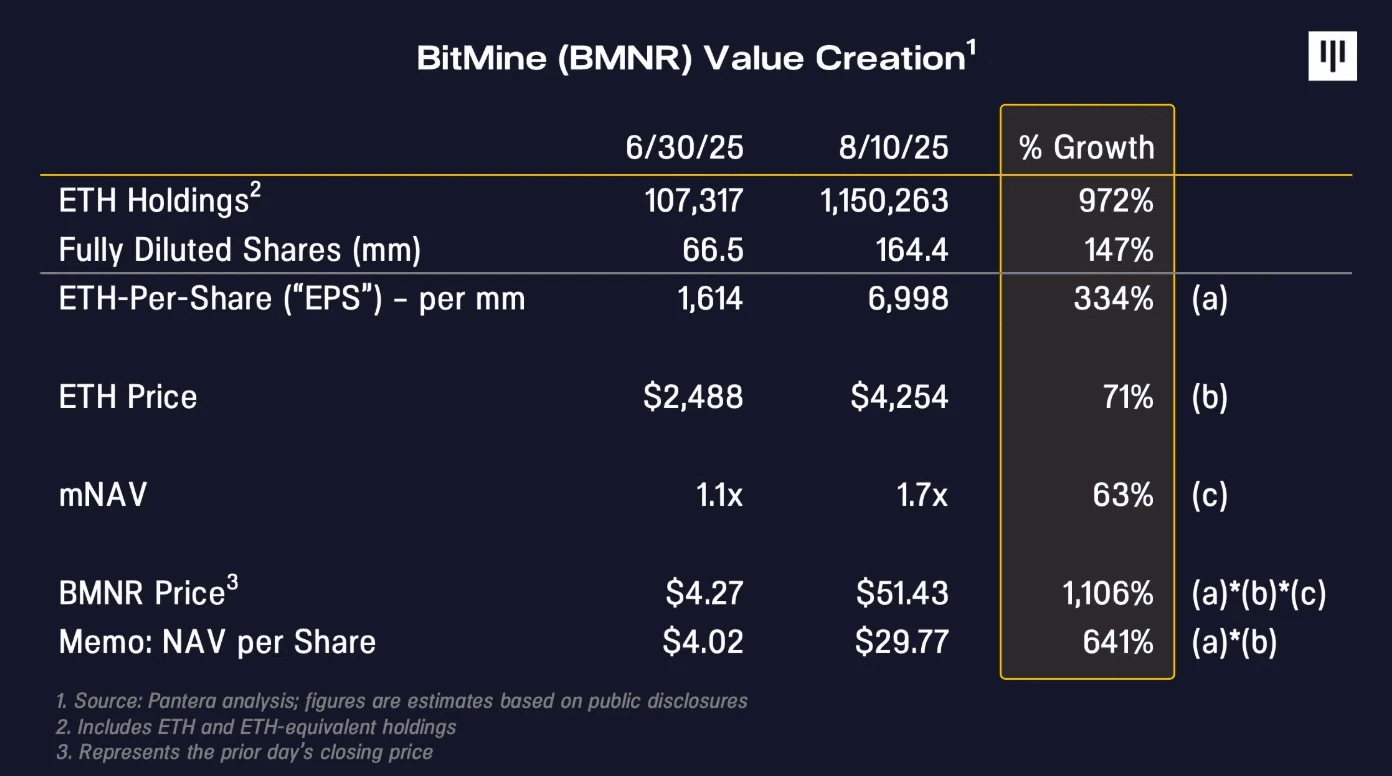
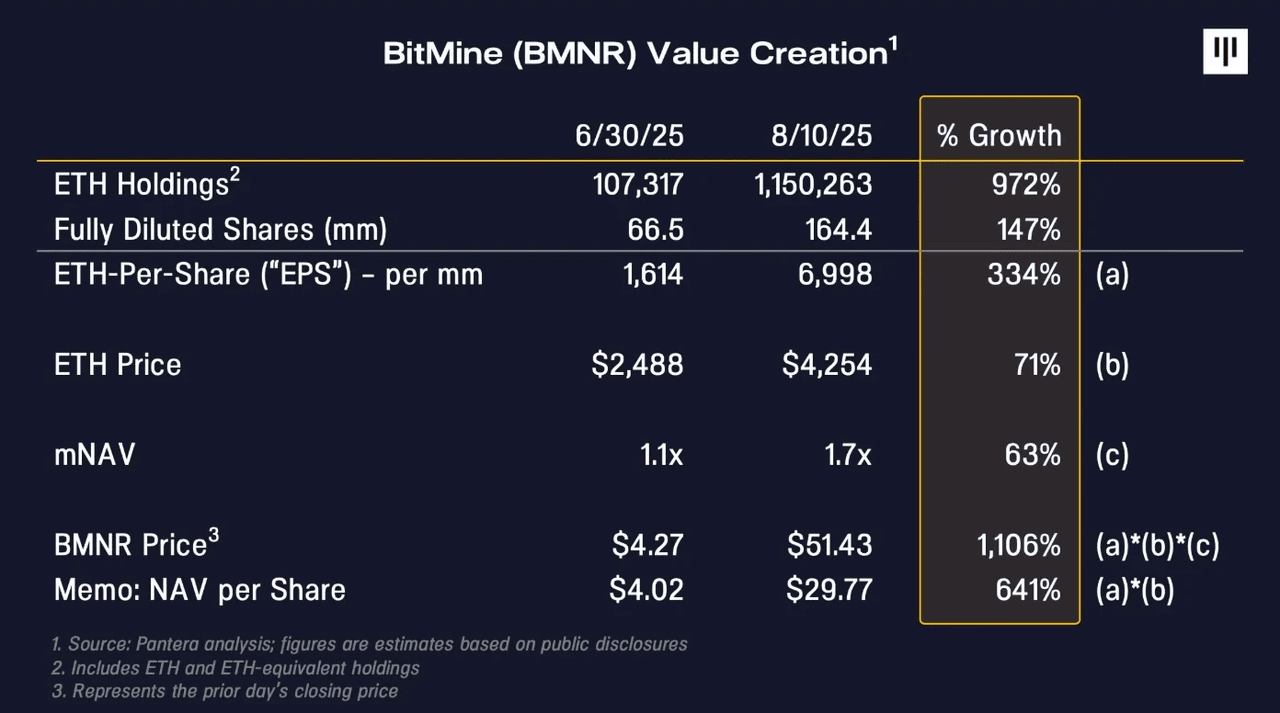
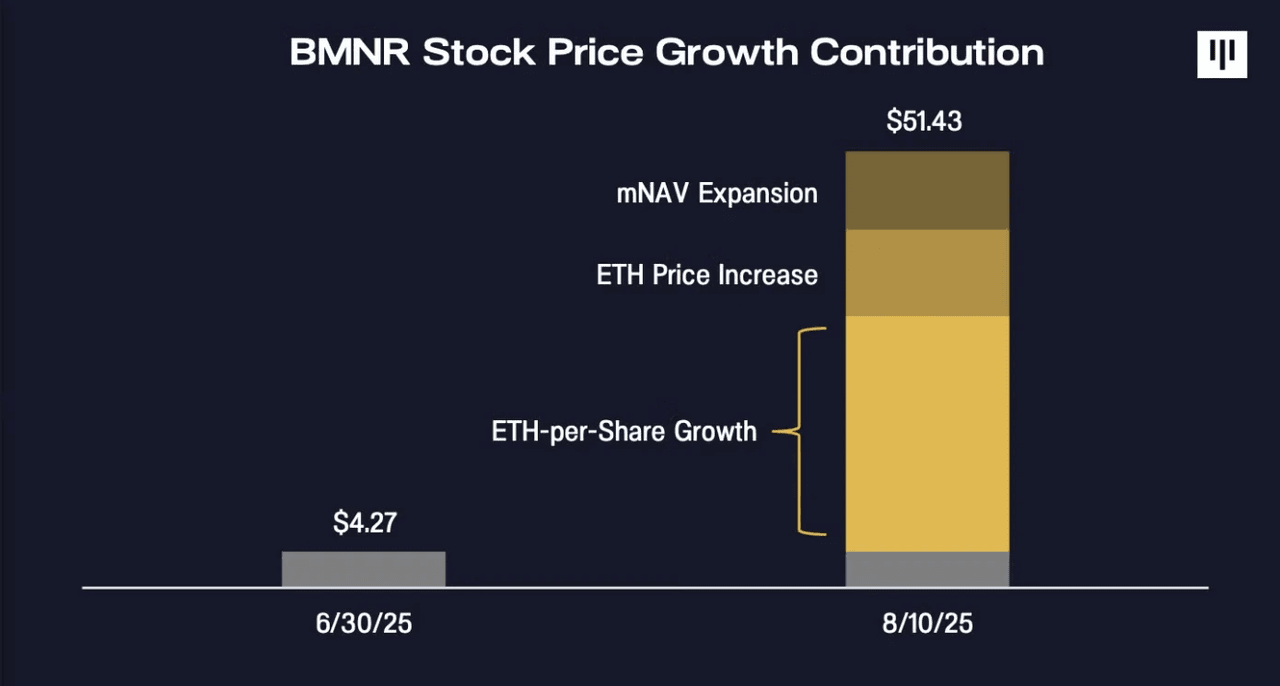
According to Pantera analysis, using BMNR as an example, the incredible rise in its stock price has a clear value-driven logic behind it. Within a month of launching the treasury strategy at the end of June, BMNR’s per-share ETH holding surged by 334%, contributing about 60% to the stock price increase; the price of ETH rose from $2,500 to $4,300, contributing about 20%; mNAV expanded from 1.1 times to 1.7 times, also contributing about 20%.
This yield decomposition structure highlights the core competitive advantage of the DAT model: the dominant factor in stock price growth is not passive fluctuations in digital asset prices, but rather the appreciation of tokens per share achieved through active capital allocation by management. In other words, investors gain not only the market returns from ETH price increases (i.e., the returns generated by fluctuations along with the market), but more importantly, the proactive returns created by management (i.e., the portion of returns not fluctuating with the market). This 'management-controlled value creation mechanism' is the core differentiated value proposition of DAT companies compared to directly holding spot assets, and explains why institutional investors are willing to pay a premium for DAT stocks.
Why choose Ethereum?
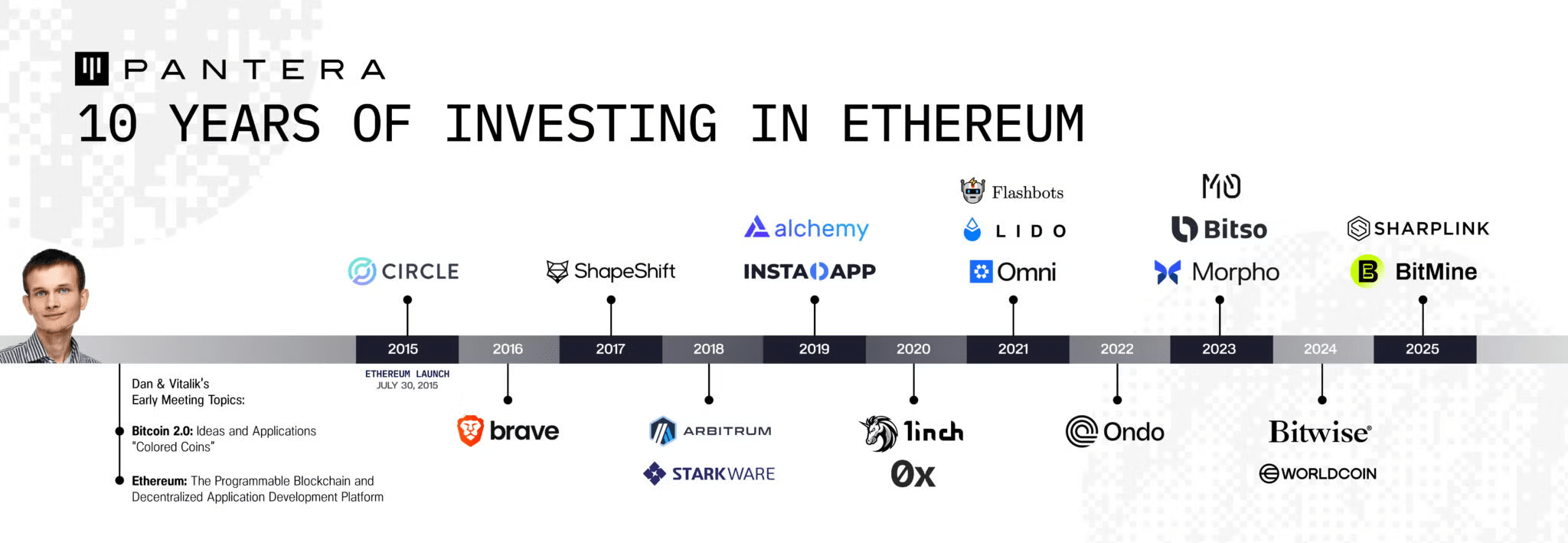
BitMine's firm choice of the Ethereum direction reflects a deep judgment about the future development direction of blockchain infrastructure. Tom Lee once stated on the Bankless podcast that Ethereum will become the infrastructure of the financialization and AI era, and the current market price is far below its true potential. As Wall Street moves on-chain, Ethereum will become one of the most important macro trends in the next decade.
• Network Effect Advantage: Ethereum has become the core infrastructure of digital finance. Ethereum hosts the vast majority of DeFi applications, NFT transactions, and enterprise-level blockchain applications. As traditional financial institutions accelerate 'on-chain' transitions, the network value of Ethereum will continue to grow.
• Diversification of Income: Compared to Bitcoin, Ethereum provides more diversified sources of income. Companies can obtain stable returns through staking via Ethereum's Proof of Stake (PoS) mechanism. As Tom Lee said: 'This essentially makes these companies like infrastructure operators, possessing stable income sources.' Additionally, staking derivatives and on-chain yield strategies in the DeFi ecosystem offer more financial innovation tools and income opportunities than Bitcoin.
• Institutional Adoption Trend: Tom Lee mentioned on the podcast: 'For many U.S. institutions, the ETH ETF may not fit their fund investment parameters, while digital asset treasury companies provide a compliant and efficient alternative.' This indicates that as institutional investors' interest in Ethereum grows, digital asset treasury companies are providing them with more investment options.
BitMine's Core Business Model: Maximizing ETH Holdings per Share
BitMine's core business model is to maximize the number of ETH held per share (EPS, ETH Per Share) — because in a digital asset bull market, the density of holdings determines the amplification multiple of shareholder returns, this metric has replaced traditional earnings per share as a key performance indicator. BitMine has taken this logic to the extreme by continually enhancing the amount of ETH per share through diversified capital allocation strategies, thereby achieving super-linear growth of stock prices when ETH prices rise.
The main ways to increase the number of tokens held per share include the following:
• Premium Issuance Strategy: Based on the theoretical framework of the above DAT model, BitMine transforms the strategy of 'stock price premium utilization' into specific operational methods. New shares are issued when the stock price has a premium relative to the NAV of ETH. The logic behind BitMine's latest plan to raise $20 billion to purchase ETH lies in this—assuming each share's NAV is $100 but the stock price is $120, the company can issue stock to obtain $120 cash to purchase equivalent ETH, thereby increasing the value of each ETH share from $100 to about $110, achieving value enhancement.
• Innovation of Derivative Tools: Issuing convertible bonds and other equity-linked securities to gain additional capital through the dual volatility of stocks and ETH. Pantera predicts that BitMine will soon expand into this area, raising funds to purchase more ETH through bond financing without diluting existing shareholders' equity.
• Staking Yield Reinvestment: The Ethereum PoS mechanism provides BitMine with additional sources of income that Bitcoin DAT companies do not possess. The annualized returns obtained from staking ETH can be automatically reinvested to purchase more ETH, creating a compounding growth effect. This is a unique advantage of ETH and other smart contract tokens in comparison to Bitcoin DAT.
• Mergers and Integration: As more companies shift to Ethereum treasury strategies, BitMine can achieve scale expansion by acquiring other DAT companies at or below NAV transaction prices.
The synergistic effect of these four growth mechanisms enables BitMine to amplify returns when ETH prices rise while maintaining competitive advantages through proactive capital allocation strategies when ETH prices fall.
Essentially, BitMine's treasury strategy is a finely designed financial engineering project, and its success depends on the management's precise grasp of market timing, skilled use of capital market tools, and accurate judgment of the long-term value of the Ethereum ecosystem. The sustainability and replicability of this model will largely determine the future development trajectory of DAT as an emerging asset class.
Summary: Future Outlook
With clear strategic planning and strong execution, BitMine is driving profound changes in the field of crypto asset management. As the chairman of BitMine’s board, Tom Lee proposed the company's long-term goal—to acquire 5% of the total supply of Ethereum, a goal referred to as '5% Alchemy.'
Ethereum treasury strategy companies are replicating the successful experiences of companies like Strategy in the Bitcoin domain, attracting several companies including Bit Digital and SharpLink Gaming to follow suit. At the same time, Pantera Capital's investment of $300 million into the DAT space demonstrates the layout of institutional capital in this emerging field.
Pioneers like BitMine are translating the successful practice of Ethereum treasury reserves into a replicable business reality. As more publicly listed companies recognize the unique value of digital assets, the strategic layout and execution experience of these pioneers will become important catalysts for driving the digital transformation of enterprises, accelerating the deep integration of traditional finance and the blockchain economy.
Reference Information:
Bitmine Immersion Technologies, Inc. Official Disclosure (PR Newswire Release): https://www.prnewswire.com/news/bitmine-immersion-technologies%2C-inc./
Pantera's research on digital asset treasury investment strategies: https://panteracapital.com/blockchain-letter/dat-value-creation/
LongHash VC's analysis on the new asset class of DAT: https://www.longhash.vc/post/digital-asset-treasury-companies-passing-fad-or-a-new-asset-class
